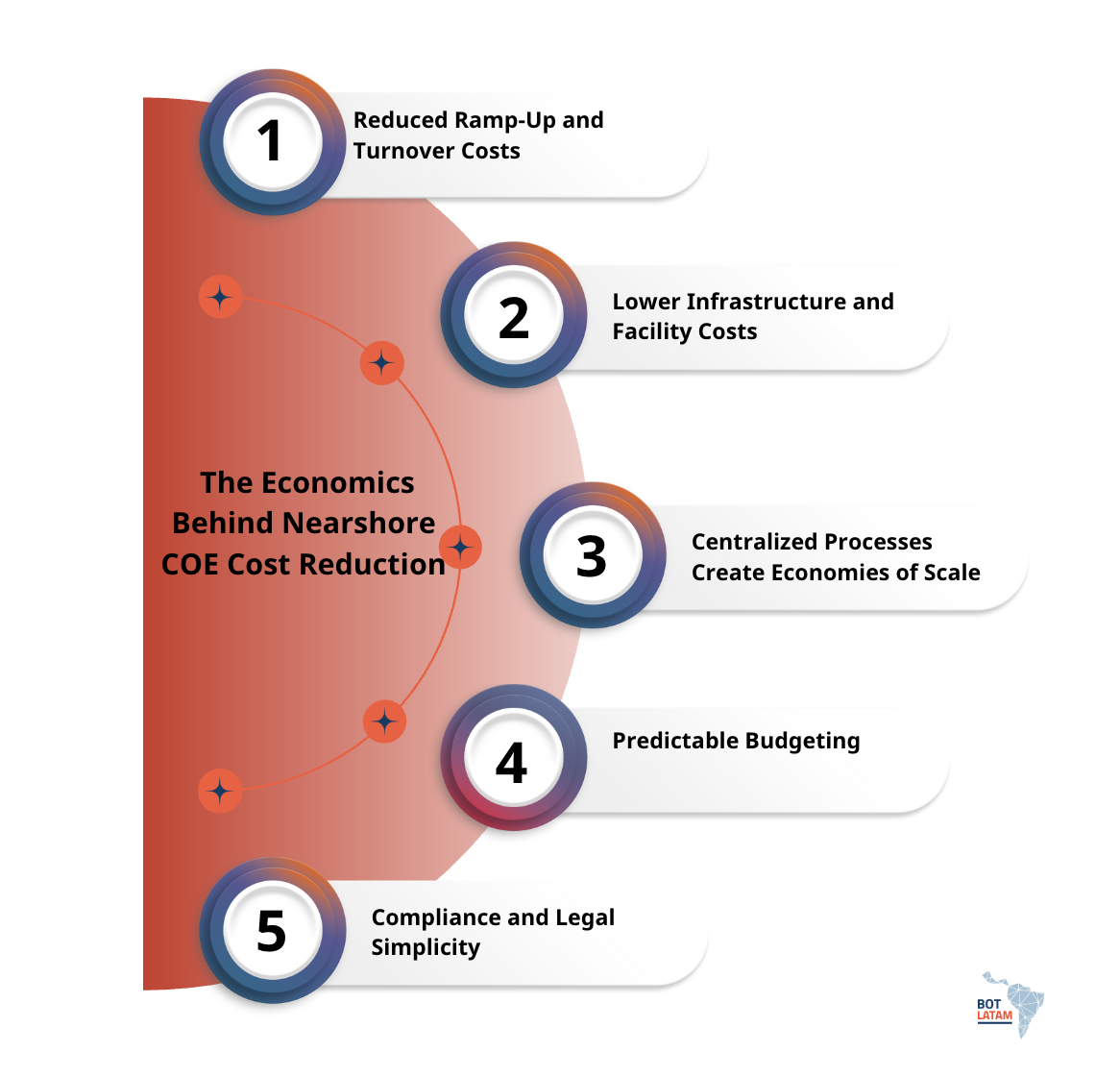Cutting software development costs by 40% isn’t just a marketing ploy created by staffing agencies. This is an achievable strategy when Nearshore Centers of Excellence (CoEs) are done right. With the right structure, location, and processes, nearshore CoEs can dramatically reduce overhead, improve delivery speed, and help you scale smarter.
A Nearshore CoE combines the benefits of nearshoring, proximity, time zone alignment, and talent availability, with the operational discipline of a centralized hub. This model helps teams cut expenses in areas like talent acquisition, onboarding, infrastructure, and long-term maintenance. According to Deloitte, 70% of companies cite cost reduction as a top driver for global outsourcing, nearshore CoEs are built to do just that.
This article breaks down how Nearshore CoEs reduce costs, compares them to other models, and highlights real-world strategies for saving money without cutting corners. You’ll also learn what drives cost-effectiveness, where companies go wrong, and what’s next for CoEs in 2025 and beyond.
The Economics Behind Nearshore CoE Cost Reduction

Nearshore Centers of Excellence (CoEs) are designed to be lean, scalable, and financially efficient. The core value lies in their structure, centralized teams placed in lower-cost, high-talent regions that align with your time zone. But how exactly do they reduce costs so effectively?
1. Reduced Ramp-Up and Turnover Costs.
Nearshore CoEs allow you to centralize training and onboarding, which slashes ramp-up times. Reusable documentation, knowledge sharing, and consistent tooling across teams prevent delays. You also avoid the high costs of churn. According to Gallup, U.S. businesses lose $1 trillion annually to voluntary turnover. Nearshore CoEs with strong culture fit and retention strategies help keep attrition low.
2. Lower Infrastructure and Facility Costs.
Office space, utilities, and local benefits cost significantly less in nearshore regions. In cities like Medellín or Guadalajara, Class A office rent can be 70% lower than in Silicon Valley or New York. Plus, many CoEs use hybrid or remote-first models, which reduce the need for physical infrastructure altogether.
3. Centralized Processes Create Economies of Scale.
By standardizing development processes, CI/CD pipelines, and DevSecOps practices, you minimize duplicate work. Nearshore CoEs give you centralized control without micromanaging, making it easier to streamline operations and enforce consistency, two key drivers of long-term cost efficiency.
4. Predictable Budgeting.
Most nearshore CoEs operate on monthly retainers or fixed-rate pricing models. That predictability makes it easier to forecast budgets, control scope creep, and manage burn rates. Unlike ad hoc outsourcing, you aren’t paying fluctuating hourly rates or dealing with scope drift that inflates costs over time.
5. Compliance and Legal Simplicity.
Operating in countries with strong trade ties and IP protections, like Mexico under USMCA, means you spend less on legal reviews, tax structuring, and contract negotiations. Reduced regulatory friction helps projects launch faster and keeps legal costs contained.
By understanding the financial levers that make nearshore CoEs cost-effective, you can make smarter decisions about where to invest and scale. It’s not just about cheaper talent, it’s about a system designed for operational and economic efficiency.
The Key Drivers of Cost Reduction in Nearshore CoEs
Nearshore Centers of Excellence deliver cost savings through more than just lower salaries. Several underlying mechanisms make these hubs a financially strategic choice. These cost drivers are baked into the model, giving you a clear path to cutting expenses without sacrificing output or quality.
1. Centralized Knowledge and Process Reuse
A core benefit of CoEs is the ability to document, refine, and reuse successful processes across projects. Instead of building from scratch every time, teams use templates, frameworks, and institutional knowledge that speed up delivery. Over time, this dramatically reduces project hours and billable effort. According to McKinsey, companies that systematize knowledge-sharing can reduce project timelines by 30% or more.
2. Time Zone Proximity Cuts Project Lag
When your teams work within a few hours of your business hours, delays drop. Quick stand-ups, real-time feedback, and overlapping workdays help prevent stalled reviews and revision loops. These efficiencies eliminate the hidden costs tied to lost time, something offshore teams often struggle to avoid. Fewer delays mean fewer budget overruns.
3. High Retention, Low Rehiring Costs
Nearshore locations often offer better retention rates than high-churn offshore markets. A stable team keeps hiring, onboarding, and training expenses down. LinkedIn data shows that replacing a tech employee can cost up to 50% of their annual salary. With fewer departures, your CoE avoids this recurring drain on resources.
4. Localized Infrastructure and Vendor Leverage
Nearshore CoEs can tap into affordable, localized resources, such as coworking spaces, IT vendors, and legal services that are a fraction of US costs. Vendors in these ecosystems are used to working with international clients, which keeps quality high and pricing competitive. In Mexico, for example, the average monthly office rental cost in key tech hubs is under $20 per square foot, compared to over $80 in San Francisco, according to Statista.
5. Currency Arbitrage and Stable Rates
Building in countries with favorable exchange rates can stretch your budget further. Currencies in markets like Colombia or Argentina often provide built-in cost advantages. Some companies also lock in rates to hedge against fluctuation, ensuring stable monthly spending. It’s not just cheaper, it's financially predictable.
7. Built-In Scalability Without Major Overhead
As your needs grow, nearshore CoEs can scale with minimal investment in facilities or management layers. Because the core infrastructure is already in place, expansion doesn’t require rebuilding from scratch. Teams are added within the same delivery framework, which minimizes onboarding costs and ramp-up lag.
8. Embedded Quality Assurance
Most CoEs integrate QA, security, and DevOps functions into the delivery lifecycle from day one. This early investment in quality reduces costly rework. The earlier bugs are caught, the cheaper they are to fix. IBM estimates that resolving defects in production can cost up to 100x more than fixing them in development.
Comparing Cost-Effectiveness: Nearshore CoEs vs Other Models
When evaluating software delivery models, cost-effectiveness often comes down to more than hourly rates. Nearshore Centers of Excellence (CoEs), traditional offshore teams, in-house development, and outsourcing vendors each carry hidden costs and trade-offs. Understanding the differences helps you make more informed, budget-conscious decisions.
Nearshore CoEs vs Offshore Development:
Offshore development often appears cheaper at first glance due to lower hourly rates, but developers in India or the Philippines may charge 30% to 50% less than their nearshore counterparts. But these savings come with friction. Time zone mismatches, communication lags, and rework inflate the true cost. According to a study by IDC, productivity losses tied to offshore misalignment can increase total project costs by up to 25%.
In contrast, nearshore CoEs offer moderate rates with high overlap in working hours, fewer revisions, and faster delivery cycles. That means more value per hour, not just lower rates. You also gain tighter integration with your internal teams, which reduces management overhead and avoids the costs of fragmented coordination.
Nearshore CoEs vs In-House Teams:
Hiring and retaining in-house developers remains expensive. In the US, the average cost of a software engineer (including salary, benefits, taxes, and overhead) can exceed $160,000 annually, according to Glassdoor. Then factor in recruiting costs, onboarding delays, and ongoing support infrastructure.
Nearshore CoEs eliminate many of these expenses. You pay for delivery, not perks, office space, or retention bonuses. With fully formed teams in place, you skip the cost and time of assembling one from scratch. The CoE model shifts the burden of staffing and operational support to a dedicated, cost-efficient structure.
Nearshore CoEs vs Outsourced Agencies:
Traditional outsourced vendors offer flexibility but often charge premium rates for shorter-term work. While they handle staffing and delivery, their incentives aren’t always aligned with your long-term goals. You pay for hours worked or tasks completed, which can lead to scope creep and inconsistent code quality.
Nearshore CoEs, by contrast, are built for continuous improvement and alignment with your internal processes. Their centralized structure helps retain institutional knowledge and deliver long-term value. Over time, this approach reduces both rework and vendor churn, two of the most overlooked cost drivers in outsourced development.
Cost Predictability Across Models:
One major advantage of nearshore CoEs is financial transparency. These hubs typically run on fixed monthly pricing or retainer-based models created by staff augmentation agencies, making budgeting straightforward. Compare that to your regular agency work, where variable hours lead to fluctuating invoices, or offshore engagements where overcommunication and time zone delays rack up hidden costs.
Best Practices for Building a Cost-Effective Nearshore CoE
Success with a nearshore Center of Excellence hinges on getting the setup right from day one. If your goal is long-term cost-effectiveness, each decision, from location to leadership, should be made with operational efficiency in mind. Here’s how to do it right.
1. Prioritize Strategic Location Selection:
The city you choose can impact total cost by 20% or more. Look beyond labor rates. Consider internet reliability, infrastructure maturity, and government incentives. For instance, cities like Guadalajara or Medellín offer lower talent acquisition costs and strong technical ecosystems, making them more cost-efficient over time than saturated hubs like São Paulo.
2. Build Around Core Capabilities, Not Just Cost:
Start with a clear understanding of which functions belong in your CoE. High-value areas like DevOps, QA automation, or platform engineering benefit the most from scale and repeatability.
3. Hire for Retention, Not Just Price:
Lower attrition saves money in the long run. Target candidates with long-term career goals in the region, not just short-term freelance experience. Offer career progression, not just salary. LinkedIn data shows that companies with strong internal growth paths see 41% lower turnover in technical roles.
4. Standardize Processes Early:
Early-stage CoEs often bleed money through inefficiencies. Use consistent frameworks for onboarding, performance reviews, and deployment. Automating workflows with tools like Jira and GitHub Actions not only saves engineering hours but also reduces rework caused by manual errors.
5. Maintain Tight Cross-Regional Communication:
Cost savings disappear quickly when delays multiply. Set up real-time communication rituals - daily standups, shared Slack channels, and synced sprint cycles. Limit reliance on asynchronous communication for critical tasks. A Gartner study found that ineffective collaboration between distributed teams leads to a 30% dip in delivery efficiency.
6. Establish Clear Ownership and Governance:
Avoid blurred responsibilities. Assign dedicated local leadership with budget accountability, and tie KPIs directly to performance metrics like cycle time, bug rates, and code reusability. Teams without a governance model tend to accumulate hidden costs in quality control and duplicate efforts.
7. Benchmark and Optimize Continuously:
Measure cost per story point, rework rates, and velocity across quarters. Then benchmark those numbers against both your internal teams and industry peers. McKinsey reports that CoEs with continuous benchmarking improve delivery ROI by up to 22% year over year.
Ready to Build Your Own Nearshore CoE with BOT LATAM?
Cutting software development costs by 40% is what nearshore Centers of Excellence are delivering for companies that structure them strategically. With the right setup, governance, and team composition, a nearshore CoE reduces overhead, improves delivery speed, and creates long-term value at scale.
At BOT LATAM, we specialize in helping businesses build and manage the BOT model across Latin America. Our teams have helped reduce project costs while maintaining enterprise-grade quality and alignment with U.S. time zones. We focus on embedded teams, not just outsourced tasks, giving you transparency, control, and results. If you're planning to scale development without overspending, we're ready to help you build the right model from the ground up. Contact us to schedule a free discovery call and learn how we can help you complete your goals!

Revolutionize Your Workflow with Our Innovative BOT Strategy!
Enhance your operations seamlessly and adapt to market demands
Contact Us

.jpg)


%2017.26.38.png)